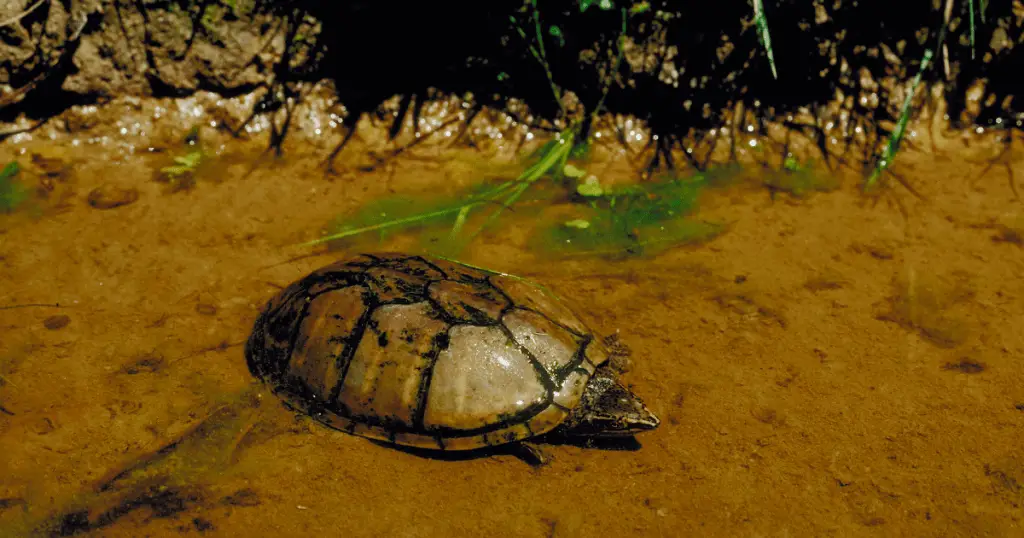Musk turtles are fascinating creatures that have become increasingly popular among pet owners in recent years. These small reptiles have specific care needs that require careful attention and dedication from their owners.
If you’re considering getting a musk turtle as a pet, it’s essential to understand what’s involved in their care and how to provide them with the best possible living environment.
This comprehensive guide will provide you with all the information you need to know about Musk turtle care. We’ll cover tank setup, feeding, and general maintenance to ensure your pet musk turtle stays healthy and happy.
Understanding Musk Turtles

Musk turtles are a fascinating species of turtle that are often kept as pets due to their small size and unique personalities. These turtles are members of the Kinosternidae family and are scientifically known as Sternotherus odoratus. They are commonly found in the eastern United States and southeastern Canada, where they inhabit watery environments like rivers, ponds, lakes, and streams.
The common musk turtle, also known as the stinkpot or eastern musk turtle, is the most popular one kept as a pet.
These turtles are known for their distinctive musky odor, which they use as a defense mechanism when threatened. While this odor can be unpleasant, it does not harm humans or other animals.
Musk turtles are omnivores, meaning they eat various foods, including fruits, vegetables, insects, and pellets.
A well-balanced diet for a pet musk turtle should consist mainly of pellets, with occasional fruits, vegetables, and dried insects. It is important to avoid feeding your musk turtle too much protein, as this can lead to health problems like shell deformities.
Regarding their habitat, musk turtles require an aquatic environment with plenty of space to swim and explore.
A 20-gallon tank is suitable for one adult Musk turtle, with an additional 10 gallons of space for each additional turtle. The water should be kept at a temperature between 75 and 80 degrees Fahrenheit, and a basking area with a heat lamp should be provided.
In summary, musk turtles are fascinating creatures that make great pets for those willing to provide proper care. By understanding their unique needs and behaviors, you can ensure that your musk turtle thrives in its environment.
Physical Characteristics
Size and Appearance
Musk turtles are relatively small turtles native to southeastern Canada and much of the Eastern United States. They are characterized by their small size, with an average length of 8-13 cm (3-5 inches) for their upper shell. The lower shell is also tiny, and they have small, fleshy barbels on their chin.
Their upper shell is oval in shape and typically dull in color, while their plastron can be pink to yellowish. Musk turtles have a flattened appearance; their carapace can be dark brown to orange with dark-bordered seams. They have a slightly serrated carapace behind them, and their head is greenish with a dark reticulum.
Distinct Features
Musk turtles have a few distinct features that set them apart from other turtle species. One of these is their tail, which is long and narrow and can be as long as their carapace. Their tails are often yellow, which can help with identification.
Another distinct feature of musk turtles is their strong odor, emitting when they feel threatened or stressed. This odor is often described as musky or skunky and is the source of their name.
In terms of behavior, musk turtles are known for their combative temperament and can be pretty aggressive. They are also primarily aquatic and spend most of their time in the water, feeding on various aquatic plants and animals.
Overall, musk turtles are tiny, unique turtles with a few distinct features that set them apart from other turtle species. Their small size, flattened appearance, and distinct features make them fascinating species to learn about and observe in their natural habitat.
Habitat and Distribution
Musk turtles are aquatic in North America, typically in the eastern United States. They are highly adaptable and can live in various habitats, including ponds, streams, and lakes. They prefer shallow water with plenty of vegetation to hide and forage for food.
The common musk turtle, also known as the stinkpot turtle, is the most widely distributed species of musk turtle. It can be found throughout much of the eastern United States and southeastern Canada, from Nova Scotia to Florida and as far west as Texas.
The loggerhead musk turtle is found in the southeastern United States, from Virginia to Florida and as far west as Louisiana. The flattened musk turtle is found in the central and southeastern United States, from Illinois to Florida and as far west as Texas. The razor-backed musk turtle is found in the southeastern United States, from Alabama to Florida.
Musk turtles are highly adaptable and can thrive in various aquatic habitats. They are commonly found in shallow, slow-moving waters with plenty of vegetation, such as ponds, streams, and marshes. They may also inhabit deeper waters but prefer areas with plenty of cover and hiding places.
The population of musk turtles has declined in some areas due to habitat destruction and pollution. However, they are still relatively widespread throughout their range. In captivity, musk turtles can be kept in aquariums with shallow water and plenty of hiding places, such as rocks and plants. They require a basking area with a heat lamp to regulate their body temperature.
Behavior and Temperament
Musk turtles are known for their calm and docile temperament, making them a popular choice as pets. These turtles can be active both during the day and night, but they are primarily nocturnal. They can swim in shallow waters or basking on rocks or logs.
Regarding behavior, musk turtles are generally solitary creatures and prefer to be left alone. They can become aggressive if they feel threatened or cornered, so handling them with care is essential. It’s also important to note that musk turtles have a robust defensive mechanism. They can emit a foul-smelling odor and release musk from glands on their body, making them less attractive to predators.
Musk turtles are also known for their unique swimming style. They tend to swim with their legs tucked in, which gives them a streamlined appearance. They are excellent climbers who can easily climb over rocks or other obstacles.
Diet and Feeding
Musk turtles are known for their diverse diets, ranging from predatory to omnivorous. They eat various foods in the wild, including fish, insects, crustaceans, and snails. As pets, providing them with a well-balanced diet that meets their nutritional needs is essential.
Carnivorous Diet
Carnivorous musk turtles require a diet that is rich in protein. Their diet should include live or frozen foods like crickets, earthworms, and small fish. It is important to note that feeding them too much protein can lead to health problems, such as kidney disease. Therefore, providing them with a balanced diet that includes other food sources is essential.
Omnivorous Diet
Omnivorous musk turtles have a more diverse diet, including plant and animal matter. They can be fed high-quality pellets and meats like chicken, turkey, beef, and pork. Vegetables such as kale, spinach, and celery are also great additions to their diet. A varied diet is essential to ensure they receive all the necessary nutrients.
When feeding your musk turtle, it is essential to remember that they have a slow metabolism and can quickly become overweight.
Therefore, feeding them small amounts of food several times a week is recommended, rather than large meals once or twice a week. It is also essential to always provide them with fresh, clean water.
Musk Turtle Care
Musk turtles are fascinating pets and relatively easy to care for. This section will cover the essential aspects of caring for a musk turtle, including tank setup, water and temperature requirements, lighting, and handling.
Tank Setup
The first step in caring for a musk turtle is to set up an appropriate tank. The ideal tank size for a musk turtle is at least 20 gallons for one turtle, with an additional 10 gallons for each additional turtle. The tank should have a basking area, a hiding spot, and a swimming area. The basking area should be dry and have a heat lamp to provide warmth. The hiding spot can be a cave or a log, and the swimming area should be deep enough for the turtle to swim and dive.
Water and Temperature Requirements
Musk turtles are aquatic, so they need a large swimming area with clean water. The water temperature should be between 75-80°F, and the basking area should be around 85-90°F. A heater and a thermometer can help maintain the temperature. The water should be filtered, and a partial change should be done weekly. The humidity in the tank should be around 50-60%.
Lighting
Musk turtles need UVB lighting to help them absorb calcium and vitamin D3. A UVB bulb should be provided for 10-12 hours a day. The bulb should be replaced every 6-12 months, as it loses its effectiveness over time.
Handling
Musk turtles are shy and can be easily stressed, so handling should be kept to a minimum. When handling a musk turtle, support its body and avoid touching its legs or tail. It’s best to handle them for no more than 10-15 minutes.
Caring for a musk turtle requires a proper tank setup, clean water, appropriate temperature and lighting, and minimal handling. With proper care, musk turtles can live up to 50 years and make fascinating pets.
Breeding and Lifespan
Breeding musk turtles can be a rewarding experience for those interested in expanding their collection of these fascinating creatures. While breeding can be challenging, it is not impossible with the proper knowledge and preparation.
Breeding Season
Musk turtles typically breed during the spring and summer, with the breeding season beginning in March and lasting until August. During this time, males become more active and chase females in the water. Male musk turtles often swim around the female and nudge her shell with their noses to get her attention.
Egg Laying
After mating, female musk turtles will lay their eggs in a suitable nest. A nesting box filled with damp soil or sand can be used in captivity. The female will dig a hole in the soil and lay her eggs, covering them up with the soil when finished. A clutch of eggs can range from 2 to 9, with an average of 4 to 5 eggs per clutch.
Incubation
The eggs of musk turtles typically take around 60 to 80 days to hatch. Keeping the eggs in a warm and humid environment is essential during this time. Many breeders use an incubator to keep the eggs at a consistent temperature and humidity level. The temperature should be around 82-86 degrees Fahrenheit, and the humidity should be around 80%.
Lifespan
Musk turtles have a relatively long lifespan, with some individuals living up to 50 years in captivity. Their lifespan is typically shorter in the wild due to predation and other environmental factors. The lifespan of musk turtles can vary depending on several factors, including genetics, diet, and environmental conditions.
Male musk turtles can reach sexual maturity as early as two years old, while females may take up to 4 years to reach maturity. It is important to note that breeding musk turtles too early can harm their health and lifespan.
Overall, breeding musk turtles can be a challenging but rewarding experience. By providing the right environment and care, musk turtles can live long, healthy life and breed successfully in captivity.
Health Concerns
Musk turtles are susceptible to various health concerns like any other living being. As a responsible pet owner, it is essential to keep a close eye on your pet’s well-being and take action immediately if you notice any signs of illness. Here are some common health concerns that you should be aware of:
Diseases
Musk turtles are prone to respiratory infections, which can be caused by poor water quality or inadequate heating. Symptoms of respiratory infections include lethargy, lack of appetite, and wheezing. If you notice these symptoms, take your pet to a veterinarian immediately.
Infections
Musk turtles can also develop skin infections, which can be caused by poor water quality or injuries. Symptoms of skin infections include redness, swelling, and discharge. If you notice these symptoms, take your pet to a veterinarian immediately.
Vitamin A
Musk turtles require adequate vitamin A to maintain healthy skin, eyes, and immune systems. A deficiency in vitamin A can lead to various health problems, including respiratory infections, eye problems, and shell deformities. To prevent vitamin A deficiency, ensure your pet’s diet includes foods rich in this essential vitamin.
Parasites
Musk turtles can be infected with various parasites, including ticks, mites, and internal parasites. Symptoms of parasite infestations include lethargy, lack of appetite, and weight loss. To prevent parasite infestations, ensure your pet’s enclosure is clean and debris-free, and feed your pet a healthy diet.
Other Health Concerns
Other health concerns you should be aware of include shell rot, which can be caused by poor water quality or injuries, and egg binding, which can occur in female musk turtles without adequate nesting sites. If you notice any signs of illness or discomfort in your pet, immediately seek veterinary care.
Musk Turtle in Captivity
Musk turtles are famous for pet owners due to their small size and relatively easy care requirements. These turtles can live up to 50 years or more in captivity, making them a long-term commitment for any potential owner. Here are some things to consider when keeping musk turtles in captivity.
Captivity
Musk turtles can be kept in captivity, but providing them with a suitable environment is essential. This includes a tank or aquarium with enough swimming, basking, and hiding space. The water should be kept clean and filtered, and the temperature should be maintained within a range of 75-80°F.
Captive-Bred
Captive-bred musk turtles are available from reputable breeders. These turtles are generally healthier and less likely to carry diseases than wild-caught specimens. When purchasing a musk turtle, it is essential to ensure it has been captive-bred and not taken from the wild.
Pet
Musk turtles can make great pets for both novice and experienced turtle keepers. They are relatively easy to care for and can be entertaining to watch. However, it is essential to remember that they are a long-term commitment and require proper care and attention.
Reputable Breeder
When purchasing a musk turtle, buying from a reputable breeder is essential. Reputable breeders will ensure that their turtles are healthy and well-cared for and provide advice and support to new owners.
Cost
The cost of a musk turtle can vary depending on factors such as age, size, and breeding. Captive-bred specimens are generally more expensive than wild-caught turtles but are also healthier and less likely to carry diseases. When purchasing a musk turtle, it is essential to factor in the cost of equipment such as a tank, filter, and heating elements.
In conclusion, keeping musk turtles in captivity can be a rewarding experience for pet owners. However, providing them with a suitable environment and purchasing from a reputable breeder is essential. By following these guidelines, pet owners can ensure that their musk turtles live long and healthy lives.
Conclusion
In conclusion, owning a Musk Turtle can be a rewarding experience for both beginner and intermediate reptile owners. These tiny aquatic turtles have specific care needs that are not difficult to meet as long as you have the correct information and tools.
Throughout this comprehensive guide, we have discussed the basic care requirements for Musk Turtles, including their habitat, feeding, and temperament. We have also provided some fun facts about these fascinating creatures.
It is important to remember that Musk Turtles are cute pets and living beings that require proper care and attention. Providing them with a suitable environment, a balanced diet, and regular health check-ups can help ensure they live long, healthy lives.
If you are considering getting a Musk Turtle as a pet, it is essential to research and ensures you are prepared to meet their specific needs. With the proper knowledge and care, these little turtles can make excellent companions for many years.
FAQ
What is the average lifespan of a Musk Turtle?
Musk Turtles have an average lifespan of 20 to 30 years. However, with proper care, they can live even longer. Factors that affect the lifespan of a Musk Turtle include diet, habitat, and overall health.
How big do Musk Turtles grow?
Musk Turtles are tiny, ranging from 2-6 inches across their shell. Adult male Musk Turtles are usually smaller than females. The size of a Musk Turtle depends on its species, diet, and habitat.
What size tank is recommended for Musk Turtles?
A 20-gallon tank is the minimum size recommended for a single Musk Turtle. However, larger tanks are always better, especially if you plan to keep more than one turtle. For every additional turtle, add 10 gallons to the tank size.
What should be included in a Musk Turtle tank setup?
A Musk Turtle tank setup should include a basking area, a water heater, a filter, and a UVB light. The basking area should be a flat rock or platform, and the water should be deep enough for the turtle to swim and dive. The water temperature should be between 75-80°F, and the basking area should be around 90°F.
Are Musk Turtles challenging to care for?
Musk Turtles are relatively easy to care for, making them an excellent choice for beginner turtle owners. They require a clean and spacious tank, a balanced diet, and regular water changes. However, like any pet, they do require some effort and attention.
Are Musk Turtles suitable for beginner turtle owners?
Yes, Musk Turtles are suitable for beginner turtle owners. They are small, easy to care for, and have a friendly personality. However, before getting a Musk Turtle, it is essential to research its care requirements and ensure that you can provide them with suitable habitats and diets.




Leave a Reply